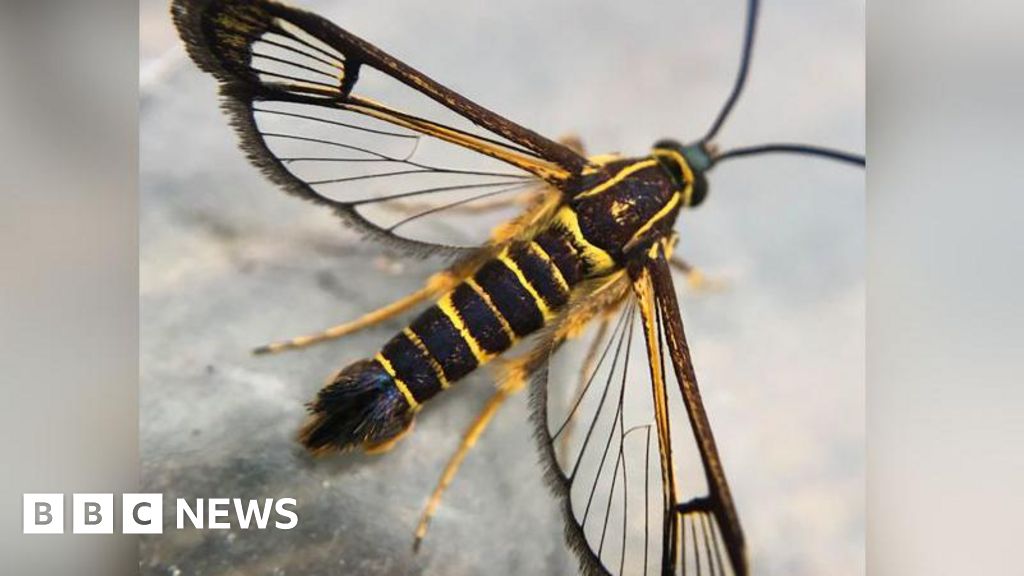Clearwing tropical moths travel 4,500 miles from Guyana to Port Talbot

 Daisy Cadet
Daisy CadetA new species of moth was found in a home in south Wales after travelling thousands of miles in a photographer’s boot bag.
Two clearwing moths appear to have hitched a ride when they were larvae, travelling 4,500 miles from a tropical jungle in Guyana, South America, before ending up in Port Talbot.
Three months later, they were spotted on a windowsill in the winter by ecologist Daisy Cadet and her mother Ashleigh in what scientists have described as an “improbable event” that “defies rational explanation”.
Through DNA analysis, the scientists confirmed the moths were not only a non-UK species, they were also previously unknown to science. The species has been named Carmenta brachyclados.
 Natural History Museum
Natural History MuseumDaisy, 22, said: “It wasn’t flying around at all – probably because the house was too cold at the time, and the other one next to it had already died.
“When I first saw them, I knew they were clearwings and assumed it was a UK species like the six-banded clearwing.
“For me, finding a new moth was exciting enough but at this point, I had no idea it was so unusual.”
To find out more about the strange moths, Daisy decided to post photos on social media platform Instagram, and a follower got in touch to say it did not look like a known UK species.
 Ashleigh Cadet
Ashleigh CadetAfter being shared widely, the images reached Natural History Museum’s moth experts Mark Sterling and David Lees.
Daisy said: “From there, it was a few months of email chains and wild-goose – or moth – chasing to work out what the moth was, and how it got to Wales.”
When Daisy checked inside her mother’s boot bag, which Ashleigh took with her during her photography trip to Guyana, she found two delicate cocoon remains – protective coverings that insects create during their pupal stage of development.
What is Carmenta brachyclados?
The specimen, which is about 18mm in length, has been named Carmenta brachyclados.
C. brachyclados’ wings are transparent, with black veins and black tips and the upperside of its body has iridescent blue stripes edged with yellow ones while the underside is a bright sulphurous yellow, the researchers said.
The humidity and and warmer temperature in the boot bag may have helped the tropical larvae survive and grow into moths during the harsh winter, the experts said.
Mark Sterling, a scientific associate at the Natural History Museum, said: “Clearwing moths are notoriously difficult to find, even by professional entomologists.
“They are even more difficult to rear from larvae or pupae, which usually dry out or go mouldy within a few days of collection.”
He said the chances of two clearwing moths from tropical jungles of South America “successfully emerging in south Wales, over three months after they arrived, in cold Welsh winter, and being preserved in good condition, is extraordinary”.
Mr Sterling said: “The improbability of this event defies rational explanation.”
Daisy said while she felt incredibly lucky to have played a role in discovering a new moth species, she also experienced “a lot of sadness and worry” about how many others are being lost to climate change.
“We are privileged to be able to make discoveries like this,” she said. “Awareness is no longer enough, and we need urgent, meaningful action to protect what remains.”
Related
Calls for over 60 free bus travel update from Department…
Calls for free bus travel for those over the age of 60 in England is gaining more attention after an increase of support. Unlike those in Wales, Scotland, and N
Major UK train station is one of the worst places…
Pickpockets are a problem across the UK, but one place is the worst for having your belongings stolen. According to the British Transport Police (BTP), just und
UK Snow Travel Chaos: Kent, East Sussex, West Sussex, Hampshire,…
UK Snow Travel Chaos: Kent, East Sussex, West Sussex, Hampshire, Wiltshire, Surrey, Berkshire, Greater London, Essex, Suffolk, Hertfordshire,
‘Only travel if necessary’ warning as UK’s busiest motorway shut…
NATIONAL Highways have issued an urgent warning to drivers as one the UK's biggest motorways shuts for the weekend. They has urged drivers to re-plan their rou












